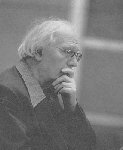 Understanding Messiaen’s music has always been problematic for me. Part of the challenge lies with his musical language. The composer’s own Modes of Limited Transposition, experimentation with total serialism, and his non-western musical influences create a complex sound environment.
Understanding Messiaen’s music has always been problematic for me. Part of the challenge lies with his musical language. The composer’s own Modes of Limited Transposition, experimentation with total serialism, and his non-western musical influences create a complex sound environment.
The other challenging element is the composer’s extra-musical ideas. Messiaen was unshakeably religious. His Catholicism permeates every note he wrote on paper. His music is imbued with religious symbolism, references to religious music and styles, and reverence for God.
Twenty gazes/contemplations on the infant Jesus is a prime example of Messiaen’s complicated music. The work is one of the most important pieces for solo piano written during the 20th century. Played from start to finish it is over two hours long and encompasses twenty movements. The "gazes" shift from harsh atonality to mesmerizing beauty.
On Friday night Dr. Christopher Bowlby, a pianist from Issaquah, Washington illuminated seven of the movements with a solid performance and thorough discussion. The recital was part of the St. Ignatius Chapel’s recital series, this year dubbed “the Chapel Keys.” Bowlby’s exploration of  Messiaen’s music was helped with the serenity of the Seattle University chapel. When I arrived in Seattle five years ago the chapel was one of the first places people urged me to visit. Though its small and unassuming, and plainly outfitted inside, it stands in stark contrast to the typical Catholic need to decorate everything in religious representational art. It was the perfect space to explore the divine.
Messiaen’s music was helped with the serenity of the Seattle University chapel. When I arrived in Seattle five years ago the chapel was one of the first places people urged me to visit. Though its small and unassuming, and plainly outfitted inside, it stands in stark contrast to the typical Catholic need to decorate everything in religious representational art. It was the perfect space to explore the divine.
For the evening Bowlby chose seven movements: Contemplation of the Father, Contemplation of the Star, Contemplation of the Virgin, Contemplation of the Son upon the Son, Contemplation of the Cross, The kiss of the infant Jesus, and Contemplation of the prophets, shepards and the magi.
Bowlby’s selections provided a good overview of the entire work. Each chosen movement prominently features the symmetrical and rhythmically enticing theme of God. Messiaen deploys the perfectly symmetrical, eternally constructed theme throughout the piece. Bowlby’s explanation of the theme added to the mystery and awe present in each movement. Bowlby’s selections also explored the early music and religious influences as well. In the Contemplation of the Star, Bowlby pointed out the movement’s plain chant qualities. In the Contemplation of the Son upon the Son, Bowlby explained and separated the complex polyphonic textures.
The choices also cast light on the numeric significance of the many of the twenty movements. In the Contemplation of the Virgin, the fourth movement, Messiaen chose the number four as a representation of humanity and in this case, Mary as that representation. Bowlby explained how the number five and each movement divisible by five references the idea of divinity.
I have no doubt Messiaen’s music will always be difficult for me. His deliberate use of a challenging musical language and religious influences begs to be decoded and I want to decode it. Each revelation revealing new questions. However, for a few hours on Friday night I glimpsed Messiaen’s divine muse.


No comments:
Post a Comment